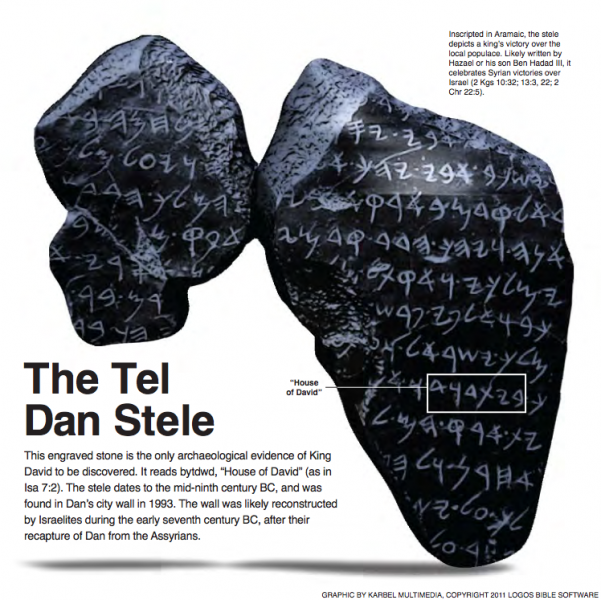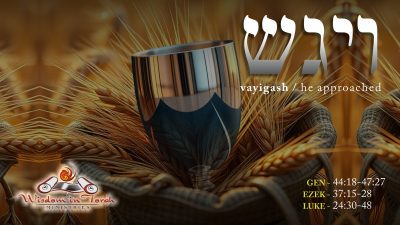2016 Israel Tour: Tel Dan

Teaching at Tel Dan. Be sure to check below with the extra info tab for more information!
Video
Audio
Resources
The following is a list of recommended resources for this teaching:
- More resources coming soon...
Tel Dan, formerly Tell el Qadi, is identified with ancient Dan of the phrase “from Dan to Beersheba” (e.g., 1 Sam 3:20). The identification was first suggested by E. Robinson in 1838 (1841: 358) and has been universally accepted. A bilingual inscription mentioning the “god of Dan,” found in 1976 in the course of the archaeological excavations, confirms the identification.
Dan is first mentioned in the Bible in Gen 14:14. At that time, the name of the city was Laish (Josh 19:47; Judg 18:29). The name Laish appears in the Egyptian Execration Texts of the 18th century b.c.e. and in Mari. Thutmose III lists Laish among the cities he conquered. See also LAISH (PLACE). The tribe of Dan, after conquering Laish, changed the city’s name to Dan. A few decades afterward the city was attacked by Arameans. In the days of the prophet Amos, the people of Israel swore “by the god of Dan” (cf. Amos 8:14). The last biblical reference to Dan is in Jeremiah (4:15; 8:16).
A. Location and Topography
B. History of the Excavations
C. History of the Settlement
A. Location and Topography
Tel Dan is located in the N of Israel (M.R. 211294), at the foot of Mt. Hermon and near one of the main sources of the Jordan river, and the tel itself has several perennial springs. It is also on the main crossroads from the Mediterranean to the E and Damascus. Tel Dan is a large mound of some 50 acres, rising close to 20 m above the surrounding plain, with a 40° sloping rampart. A gentle slope from the high circumference of the mound towards the center of the site gives a slightly concave appearance to the mound.
B. History of the Excavations
Excavations began in 1966, initially as a rescue operation, and have continued almost without interruption under the direction of A. Biran. By 1987, 20 seasons of excavation had taken place.
The very nature of a rescue excavation dictates the strategy of the excavation; and at Tel Dan it also determined, to a large extent, the strategy of subsequent seasons. Thus for a number of seasons work concentrated on the S slopes of the mound in area A, where a trench was cut from top to bottom in 1966 and in a number of squares opened on the mound itself in area B.
In 1966 the excavations in area A revealed the MB glacis and a flagstone pavement. This flagstone pavement was discovered later to have formed part of the Iron Age gateway. To study further the method of construction of the MB ramparts discovered in 1966, a trench was opened in 1972 on the NE slope of the mound (area Y) and another on the SE corner in 1978 (area K).
In the third season of excavations, area H was opened E of area B and on the N side of the mound near the spring area T, where the cult center was discovered. A number of squares were opened in 1980 in the center of the mound (area M), an area which was undisturbed by later burials. The main areas of excavations from 1982–86 have been in areas B and T, at the S and N edge of the mound respectively.
C. History of the Settlement
Tel Dan was first settled in the Pottery Neolithic period, around 5000 b.c.e. Evidence for this conclusion came from a small section in area B where bedrock was reached. Because of the small area excavated, the nature of the settlement could not be determined. It may be assumed, however, that it extended to other parts of the site. The abundant water supply would justify such an assumption.
There followed a gap in the history of occupation until the EB II, approximately the 27th century b.c.e. Undisturbed levels of occupation of the 3d millennium were reached in a number of sections spread over an extensive area, and we concluded that the EB remains cover the entire 50-acre site. This conclusion was supported by the fact that in practically every basket of excavated material EB shards were found. These, together with the complete vessels found in the stratified areas of excavation, indicate that a large and prosperous city, probably called Laish, with a rich material culture, existed at our site around the middle of the 3d millennium b.c.e. Storage jars with combed patterns, a decorated bone handle, platters with a red burnished slip, jugs, and juglets some of which are of the Abydos type, animal figurines, and a large number of seal impressions are but a tantalizing indication of the wealth of the city in the EB II and III periods still to be excavated.
The following period, EB IV, is not well represented at our site. Nevertheless, sufficient evidence was brought to light to indicate that the site had not been abandoned, although the nature of the settlement cannot be determined at this stage of our research.
The beginning of the 2d millennium b.c.e. witnessed the gradual development of the city we know was called Laish in the 18th century b.c.e. Three strata of occupation belonging to the MB I period were found. A stone-built tomb with a characteristic MB I juglet and decorated vessels similar to the so-called Khabur ware from N Syria precede the massive fortifications, which gave the site the shape it has to this day.
This system of defenses consisted of a central core with sloping earthen ramparts against both sides of the core. The earth for the ramparts came from the debris of earlier strata (esp. from the large EB city) and from the natural soil of the surrounding plain. The core on the S slope was 6.3 m thick and built of undressed stone. It is preserved to a height of about 10 m. The same principle of construction was discovered on the NE side of the mound, where the builders used an existing sloping stone structure as the core. In area K the core was built of stone and mudbrick. The base of the rampart construction is about 50 m wide. It is estimated that in order to build the ramparts about 800,000 tons of material had to be used, a task which would require a thousand workers three years to complete. The most remarkable feature of this construction was the triple-arched gate discovered at the SE corner of the rampart in area K. See Fig. DAN.01 and Fig. FOR.01.
The gate is built of sun-dried mudbrick with stone steps approaching it from the E plain and similar steps descending into the city on the W. The gate structure, the N half of which was partially excavated, stands 7 m high and consists of two towers, each about 5.15 m wide, which flank on the E and W a recessed arched gateway 5.15 m wide. Some 47 courses of mudbrick are preserved and the remains of white lime and calcite plaster which covered the brick still adhere to the joins between the courses. The interior of the gate is bisected by a N-S brick wall found standing to a height of approximately 4 m. In the center of this wall is an archway. A third arch was uncovered on the W side of the gate structure. The passage through the arches divides the gate into four chambers. The length of the passage is 10.5 m and that of the entire structure 13.5 m. Examination of the pottery found in the composition of the mudbricks, on the steps, and on the floor of the gate lead us to conclude that the gate was built around the middle of the 18th century b.c.e., the date we had ascribed originally to the construction of the ramparts. The gate and ramparts may belong to the city of Laish mentioned in the Egyptian Execration Texts. Possibly they represent the historical memory reflected in Gen 14:14.
DAN.01. E facade of MB mudbrick gate with arch at Dan. See also Fig. FOR.01. (Courtesy of Hebrew Union College-Jewish Institute of Religion and the Israel Department of Antiquities and Museums.)
The gate apparently was not long in use. The discovery of retaining walls and of stone structures built to support the walls of the towers suggests structural defects; and, with these, it was still necessary to abandon the gate. The passageway and chambers were filled with compacted earth, and the entire structure was buried. Entrance to the city was then through one of the gates which no doubt existed in other parts of the rampart. Remains of such a gate were found in the course of the excavations on the S side of the city.
During the MB, the city was about 30 acres and was a city with a rich material culture, evidence for which comes in the offerings found in well-built stone tombs and jar burials. A large assemblage of pottery vessels (some with a close affinity to the N), bronze weapons, and ivory cosmetic boxes were found. Especially numerous were the large open bowls, jugs and juglets, and carinated bowls of all sizes. Also found were Yahudiyeh type juglets and two scarabs. The vessels are to be dated to the MB II and III. Evidence of a destruction at the end of this period comes from two squares in which a thick layer of destruction by fire was found, containing cooking pots, bowls, and juglets of the end of the MB III.
While Laish appears in a historical context in the lists of Thutmose III, the excavations have so far shed no light on this campaign, but two finds reflect contacts with Egypt. One is a red granite statuette of a man in a sitting position, Nefertem by name, found in secondary use in a wall of the Israelite period. The statuette is of a well-known type used in the ritual of the dead, dated to the 19th Dyn., ca. the 14th century b.c.e. Another fragment of an Egyptian statuette was found on the surface. Originally from the Middle Kingdom, it bears a secondary inscription of the Ptolemaic period.
The LB is represented by a large building the stone walls of which are preserved to a height of 1 m. The S and E walls have been exposed to a length of 6 and 7 m respectively. The floor is of flat stones. A female ceramic figurine, possibly a mask, was found in the debris. See Fig. DAN.02. Other remains from the LB period were found in practically all areas excavated. Area B yielded a tomb built of rough basalt stones which contained 95 vessels (26 of which were imported), 4 basalt bowls and 2 stone vessels, 4 ivory boxes, 6 bronze bowls, a bronze shovel, a bronze oil lamp, 2 daggers, 2 swords, numerous arrowheads, and silver and gold jewelry; these indicate the wealth and cosmopolitan character of the city in the LB. Especially significant is the discovery of a complete charioteer vase.
In area Y a scarab of Rameses II and a stirrup jar were found. A large krater with four handles, two decorated storage jars, imported bichrome ware, a unique plaque of a dancer playing the lute, and remains of metal workshops (all from area B) add to our knowledge of the LB city.
The evidence for the arrival of the Danites is both textual and archaeological. Judges 18 gives a detailed account of the migration of the tribe of Dan and the conquest of Laish the name of which they changed to Dan. The excavations did not reveal the devastation implied in Judg 18:27, but the appearance of a stratum of occupation characterized by pits implies a drastic change in the material culture of the population. The new inhabitants, like their predecessors, lived within the ramparts, but their lifestyle was different. The new Danite inhabitants probably lived in tents and huts and stored their food in pits. These stone-lined pits were dug into the earlier levels of occupation and contained Iron Age cooking pots and a new type of storage jar, the “collared-rim” jar. The arrival of the Danites and the conquest of Laish took place around the beginning of the 12th century b.c.e.
According to Judges 18 the Danites brought with them a priest as well as the pesel, the ephod, the teraphim, and the masekhah. It is probable that the Danites erected a structure to hold these cult objects, possibly a temple, where the priests could also officiate. While the remains of this early sanctuary have not yet been found, its existence must have prompted Jeroboam to establish one of the golden calves at Dan towards the end of the 10th century b.c.e.
DAN.02. Terracota face of a woman, possibly a mask—LB period. (Photograph by Z. Radovan, courtesy of Hebrew Union College-Jewish Institute of Religion and the Israel Department of Antiquities and Museums.)
The seminomadic character of the tribe of Dan did not last long. Soon after settling in their new locale, they built houses of stone and developed a metal industry. A large number of crucibles containing bronze sediment and slag, clay tuyeres, basalt slabs, and tools were found in enclosed areas which served as workshops. Although some evidence for metallurgical activity occurs in the LB, the development of the metal industry into a major economic enterprise seems to have been the result of Danite initiative.
The Danites were to enjoy a period of relative peace and prosperity until about the middle of the 11th century b.c.e., when the city was destroyed in a fierce conflagration. The city, however, was not abandoned, and the houses were soon rebuilt using the original walls. The vessels continue the tradition of the previous period. Peace followed for about two centuries.
Toward the end of the 10th century, Jeroboam established the N kingdom and made Dan the main cult center in the N of the country. He set up a golden calf at Dan, which apparently became a more important sacred site than Bethel (1 Kgs 12:30). Remains of the sanctuary built by Jeroboam were uncovered in area T at the N edge of the site.
DAN.03. Base of canopied structure and bench within the stone gate at Dan—Iron Age. (Courtesy of Erich Lessing/Art Resource, NY.)
A rectangular platform, ca. 7 × 19 m, built of large dressed limestone blocks was discovered; also found were parts of large storerooms in which were two large pithoi (ca. 300 liters each) decorated with a snake motif and numerous vessels. A decorated incense stand, chalices, a bowl with a trident incised on its base, and the broken head of a male figurine form part of an assemblage of a cultic nature dated to the late 10th or early 9th centuries b.c.e. Further S an installation consisting of a sunken basin flanked by two basalt slabs and two plastered jars was uncovered and found to contain faience figurines. North of the basin another pithos with a snake decoration was found. In a paved courtyard S of the basin, broken parts of a clay tub were discovered. The tub, 1.5 m long,.6 m wide, and.5 m deep, had a seat at one end. The stone pavement extended to the edge of a rectangular pool fed through a channel from the nearby spring. We believe the entire installation served as part of water libation ceremonies.
The establishment of a cult center at Dan called also for special security—remains of massive fortifications, a city wall, and a gate were uncovered at the S foot of the mound. In the 9th century b.c.e. a 4 m thick city wall and gate complex which included an outer gate with a large paved sqaure were built. The gate has four chambers and a monumental paved entryway leading up to the top of the mound. Between the two gates is a stone-paved piazza, 19.5 × 19.4 m, with a bench for the elders and a canopied structure where the king may have sat (see Fig. DAN.03; cf. 1 Kgs 22:10). Ahab, who had trading rights in Damascus, may have been the king who thus fortified Dan against possible attack by the Arameans. Also in the 9th century, considerable building activities took place in the area of the sacred precinct. A large almost-square structure, about 19 × 19 m, built of ashlars laid in headers and stretchers, was uncovered. The structure, probably a high place or bamah, was surrounded on three sides by a courtyard of crushed yellowish limestone. S of the bamah were two square surfaces of flat ashlars. A four-horned altar, one horn of a much larger altar, remains of the bases of circular columns, and pottery vessels were found. West of the bamah a complex of buildings, including an altar room with a sunken jar containing ashes and with three iron shovels, were excavated in the 1985–86 seasons. It appears that in the 9th and 8th centuries the sacred precinct at Dan had reached its zenith. See Figs. DAN.04 and DAN.05.
The city enjoyed a period of prosperity due perhaps to the victories of Jeroboam II in N Syria. An upper gate was built on the ridge of the mound and in the houses a large repertoire of Iron II vessels came to light. How the Assyrian conquest of N Israel affected Dan is not clear. In any case, the stone pavement continued to serve as a road leading northward into the city and to the sacred precinct. The houses of the 7th century were well built and in one quarter they were built around a large stone-paved courtyard. A large quantity of vessels, including decanters, storage jars, cooking pots, oil lamps, and a shard with the name Baal-Pelet, indicate that the settlement at Dan continued to prosper until the Babylonian Conquest.
DAN.04. Israelite altar at Dan consisting of five stones and sunken jar containing ashes. (Courtesy of Hebrew Union College-Jewish Institute of Religion and the Israel Department of Antiquities and Museums.)
Following the Babylonian Conquest, there is little archaeological evidence of the history of the city—only scattered shards of the later periods were found in areas B, K, M, and Y. The chambers of the upper gate were blocked and benches were built along the walls. The pavement, however, continued in use through the Hellenistic period. At the foot of the mound where the Iron Age gate was originally located, two cisterns and clay pipes which brought water from the spring date to the Roman period. Another cistern or plastered pool and burials of the Roman period were uncovered on the slope. The Roman settlement was apparently limited to the SW area of the site, where a large number of shards were found on the surface. The sacred precinct, however, continued with those activities connected with the sanctuary.
West of the high place, the remains of a wall and shards of storage jars and oil lamps of the Persian period were uncovered. On one shard the impression of a magnificent lion was found. A number of figurines, possibly from a favissa, belong to the end of the Persian or to the beginning of the Hellenistic period. A figurine of the god Bes, two of the god Osiris, one of a smiling Astarte, another of woman and child, a figurine of a rider, coins of Ptolemy I (4), of Antiochus III (2), and of Ptolemy II (4), and a figurine of a temple boy indicate activities in and around the sanctuary in the 4th–3d centuries b.c.e.
DAN.05. Iron shovels found with the altar at Dan. (Courtesy of Hebrew Union College-Jewish Institute of Religion and the Israel Department of Antiquities and Museums.)
During the Hellenistic and Roman periods considerable building activities took place in the sacred precinct. A well-built enclosure wall with the entrance from the S surrounded the sanctuary during the Hellenistic period. A plastered circular basin, coins of Antiochus IV and Demetrius II, oil lamps, and a bilingual inscription attest to the fact that the sanctuary continued to serve the community of Dan and the surrounding area. The inscription is especially significant. Written in Gk and Aram, it reads: “To the god who is in Dan, Zoilos made a vow.” See Fig. DAN.06.
During the Roman period the entrance in the Hellenistic wall was blocked and new walls were built next to it. West of the enclosure wall a fountain house was built. Steps led down to plastered basins which were fed by water brought from the spring through a clay pipe. The overflow was returned to the spring in an open channel. Some 38 coins of Constantine I and Constantine II may have belonged to the pilgrims who visited the sanctuary in the 3d and 4th centuries c.e. The last reference to Dan was by Eusebius, who stated that it was located 4 miles from Paneas.
DAN.06. Bilingual inscription (Greek and Aramaic) from Dan, reading “To the god who is in Dan.” (Photograph by Z. Radovan, courtesy of Hebrew Union College-Jewish Institute of Religion and the Israel Department of Antiquities and Museums.)
Bibliography
Biran, A. 1970. A Mycenean Charioteer Vase from Tel Dan. IEJ 20: 92–94.
———. 1971. Laish-Dan—Secrets of a Canaanite City and an Israelite City. Qad 4: 2–11 (in Hebrew).
———. 1974. Tel Dan. BA 37: 26–51.
———. 1980a. Tel Dan. BA 43: 168–82.
———. 1980b. Two Discoveries at Tel Dan. IEJ 30: 89–98.
———. 1981a. The Discovery of the Middle Bronze Age Gate at Dan. BA 44: 139–44.
———. 1981b. To the God who is in Dan. Pp. 142–51 in Temples and High Places in Biblical Times, ed. A. Biran. Jerusalem.
———. 1982. The Gate of Laish at Dan. Qad 15: 107–12 (in Hebrew).
———. 1984. The Triple-Arched Gate of Laish at Tel Dan. IEJ 34: 1–19.
———. 1986a. The Dancer from Dan, the Empty Tomb and the Altar Room. IEJ 36: 168–87.
———. 1986b. An Incense Altar and Other Discoveries at Dan. Qad 19: 27–31 (in Hebrew).
Malamat, A. 1970. Northern Canaan and the Mari Texts. Pp. 164–77 in Near Eastern Archaeology in the Twentieth Century, ed. J. A. Sanders. Garden City.
———. 1971. The Danite Migration and the Pan-Israelite Exodus-Conquest. Bib 51: 1–16.
———. 1971. Syro-Palestine Destination in a Mari Tin Inventory. IEJ 21: 35–38.
Mazar, B. 1954. Canaan on the Threshold of the Age of the Patriarchs. EI 3: 18–31 (in Hebrew).
Robinson, E. 1841. Biblical Researches in Palestine. Vol. 3. London.
Stager, L. E., and Wolff, S. R. 1981. Production and Commerce in Temple Courtyards: An Olive Press in the Sacred Precinct at Tel Dan. BASOR 243: 95–102.
Yadin, Y. 1965. And Dan, Why Did He Remain in Ships? AJBA 1: 9–23.
Biran, A. (1992). Dan (Place). In D. N. Freedman (Ed.), The Anchor Yale Bible Dictionary (Vol. 2, pp. 12–17). New York: Doubleday.
Rico Cortes
1 thought on “2016 Israel Tour: Tel Dan”
Leave a Comment Cancel Reply
You must be logged in to post a comment.







Thank you Rico!!! Great teaching and so profound what you presented!! May HaShem’s the esteem and honor of HaShem’s Great Name be restored!!! Baruch HaShem!!!
I am asking the Great King if possible may I go on a trip to Israel with you!! I went in 2007 and it was life changing and to go back to the Land of my Great King with you would be a great honor and experience!!
Shalom in Mashiach Yeshua!!